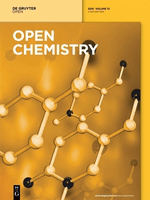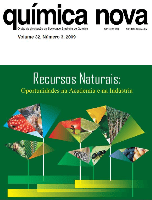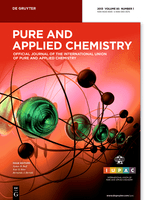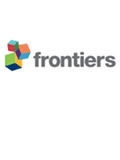
French-Ukrainian Journal of Chemistry
Scope & Guideline
Empowering Research Through Open Access
Introduction
Aims and Scopes
- Drug Design and Development:
The journal emphasizes research on new chemical entities and drug design, showcasing studies that explore the synthesis and biological evaluation of compounds with potential pharmacological applications. - Environmental Chemistry and Toxicology:
There is a consistent focus on studies assessing the environmental impact of chemicals, including the analysis of toxic elements in various ecosystems and their effects on health. - Polymer Chemistry and Materials Science:
Research on the synthesis, characterization, and applications of polymers, including biocomposites and their physical properties, is a key area of focus in the journal. - Analytical Chemistry Techniques:
The journal features advancements in analytical methodologies for chemical analysis, including spectrophotometric techniques and titration methods, highlighting their applications in various fields. - Biological and Medicinal Chemistry:
Investigations into the antioxidant activities, phytochemical properties, and potential medicinal benefits of natural compounds are prominently featured, reflecting the journal's commitment to interdisciplinary research.
Trending and Emerging
- Computational Chemistry and Cheminformatics:
There is a rising interest in computational approaches, including molecular modeling and cheminformatics, which are being used to predict the behavior of compounds and facilitate drug discovery processes. - Biochemical and Medical Applications:
Research focusing on biochemical markers, cancer biomarkers, and the medicinal properties of natural compounds is increasingly prominent, highlighting a growing intersection between chemistry and health sciences. - Green Chemistry and Sustainable Practices:
The journal is seeing an uptick in studies promoting sustainable chemistry practices and eco-friendly synthesis methods, reflecting a global push towards environmentally responsible research. - Nanomaterials and Their Applications:
There is a notable increase in research related to nanomaterials, particularly in their applications for drug delivery, environmental remediation, and as catalysts, indicating a trend towards utilizing nanotechnology in chemical research. - Corrosion Science and Material Protection:
Emerging studies on corrosion inhibition and material protection strategies are gaining attention, reflecting a practical approach to extending the life of materials in various industrial applications.
Declining or Waning
- Traditional Organic Synthesis:
There has been a noticeable decrease in publications focused solely on traditional organic synthesis methods, possibly due to a shift towards more innovative and efficient synthetic approaches that leverage modern technologies. - Physical Chemistry Studies:
Research papers concentrating on classical physical chemistry topics have become less frequent, suggesting a waning interest in fundamental studies in favor of applied research that addresses real-world problems. - Agricultural Chemistry:
While agricultural chemistry has been a topic of interest, recent publications indicate a decrease in studies related to agrochemicals and soil chemistry, possibly due to a broader focus on environmental and health-related topics.
Similar Journals

Bulletin of the University of Karaganda-Chemistry
Fostering Collaboration in Chemical Research ExcellenceBulletin of the University of Karaganda-Chemistry is an esteemed academic journal published by KARAGANDA STATE UNIVERSITY, focusing on the field of chemistry and related disciplines. With an ISSN of 2518-718X and an E-ISSN of 2663-4872, this journal aims to disseminate high-quality research articles, reviews, and scholarly discussions that contribute to the advancement of knowledge in chemistry. Although it has experienced a transition in its coverage from 2021 to 2022, the journal remains a significant platform for researchers and students alike, promoting open access to its valuable content. Despite its current Scopus rank of #379/407 in the general chemistry category, the Bulletin of the University of Karaganda-Chemistry serves as a vital resource for the academic community in Kazakhstan and beyond, fostering collaboration and innovation in various chemical research domains. Researchers, professionals, and students are encouraged to engage with the journal as it continues to evolve and contribute to significant scientific discussions.

RUSSIAN JOURNAL OF GENERAL CHEMISTRY
Connecting Innovators in Chemical ResearchThe Russian Journal of General Chemistry is a prominent scholarly publication dedicated to advancing the field of general chemistry. Published by MAIK NAUKA/INTERPERIODICA/SPRINGER, this journal contributes significantly to the global chemistry landscape, offering a platform for researchers and professionals to share their latest findings and methodologies. With an ISSN of 1070-3632 and an E-ISSN of 1608-3350, it has established itself as a resource for high-quality research articles since its inception in 1996. Though currently indexed in the Q4 category for chemistry (miscellaneous) and ranking #299 out of 408 in general chemistry according to Scopus, the journal remains an important venue for academic contributions that bridge gaps in traditional chemical disciplines. Desiring to cater to a diverse range of interests within chemistry, the journal actively encourages submissions that reflect significant scientific achievements, innovations, and collaborative studies. Although the journal does not currently offer open access, its role in disseminating crucial chemical research cannot be overstated. Researchers and students alike will find valuable insights and rigorous scientific discourse in its pages.

Ovidius University Annals of Chemistry
Unlocking Knowledge in Chemistry and Engineering.Ovidius University Annals of Chemistry is a prominent open-access journal dedicated to the field of chemistry and chemical engineering, published by OVIDIUS UNIV PRESS since 2012. With its ISSN 1583-2430 and E-ISSN 2286-038X, this journal seeks to foster innovative research and disseminate knowledge across diverse chemical disciplines. Situated in the vibrant academic setting of Ovidius University in Constanta, Romania, this journal receives contributions from a global pool of researchers, enhancing its relevance in the international scientific community. The open-access format ensures that all published articles are freely available, promoting a wider reach and impact of the research dissemination. As a valued resource for academics, industry professionals, and students alike, the Ovidius University Annals of Chemistry plays a crucial role in advancing the understanding of chemical sciences and engineering practices.

Open Chemistry
Pioneering Open Access to Cutting-Edge Chemical InsightsOpen Chemistry, published by DE GRUYTER POLAND SP Z O O, is a distinguished peer-reviewed journal that has been serving the global chemistry community since its inception. With an ISSN of 2391-5420 and an E-ISSN also of 2391-5420, this open-access journal has been accessible to researchers and practitioners alike since 2015, ensuring a wide dissemination of high-quality research findings. Located in Germany, specifically at BOGUMILA ZUGA 32A STR, 01-811 WARSAW, MAZOVIA, POLAND, Open Chemistry aims to publish innovative research across various chemical disciplines, with special attention to miscellaneous chemistry and materials chemistry. It is currently ranked in the Q3 category for both fields as of 2023, reflecting its solid standing within the academic community, with specific ranks of 187/408 in General Chemistry and 153/317 in Materials Chemistry, corresponding to respective percentiles of 54 and 51. Open Chemistry not only enhances the accessibility of cutting-edge research but also serves as a vital resource for students, professionals, and scholars seeking to advance their knowledge in the rapidly evolving landscape of chemical sciences.

QUIMICA NOVA
Innovative Research for a Global Chemistry CommunityQUIMICA NOVA is a premier open access journal published by the SOC BRASILEIRA QUIMICA, dedicated to advancing the field of chemistry through the dissemination of high-quality research. Since its inception in 1997, the journal has provided a platform for innovative studies and scientific dialogue, making it a valuable resource for researchers, professionals, and students alike. With a focus on miscellaneous areas of chemistry, QUIMICA NOVA occupies a notable position with a 2023 Scopus ranking of #289 in General Chemistry, representing the 29th percentile among its peers. The journal's commitment to accessible science is underscored by its open access model, enabling broader readership and engagement. Hailing from Brazil, QUIMICA NOVA continues to contribute significantly to the global chemistry community, providing insights that drive progress and foster collaboration across disciplines.

PURE AND APPLIED CHEMISTRY
Pioneering Insights in Chemical Engineering and BeyondPURE AND APPLIED CHEMISTRY is a highly regarded journal in the fields of chemical engineering and general chemistry, published by Walter de Gruyter GmbH. Since its inception in 1960, this journal has continued to foster advancements in chemical research and facilitate the dissemination of new knowledge through its rigorous peer-reviewed articles. With an impressive impact factor that places it in Q2 quartile rankings for both Chemical Engineering and Chemistry as of 2023, it holds a significant position in the academic landscape, attracting authors and contributors from around the globe. The journal’s unique focus on the practical applications of chemical research makes it indispensable for researchers, professionals, and students aiming to bridge theoretical knowledge with real-world applications. Although it is not open access, its impact is enhanced by its continued relevance and contributions to the ever-evolving field of chemistry. Researchers and practitioners alike will find in PURE AND APPLIED CHEMISTRY a critical resource for staying updated on key developments and innovative practices in chemistry and chemical engineering.

Frontiers in Chemistry
Exploring Diverse Dimensions of Chemical Science.Frontiers in Chemistry is an esteemed and innovative Open Access journal published by FRONTIERS MEDIA SA, based in Lausanne, Switzerland. Since its inception in 2013, the journal has established itself as a leading platform for the dissemination of high-quality research across a broad spectrum of chemistry disciplines, achieving a notable Q1 classification in the miscellaneous chemistry category as of 2023. With an impressive Scopus rank, placing it at 72nd out of 408 in General Chemistry and falling within the 82nd percentile, Frontiers in Chemistry is committed to publishing significant findings that contribute to the advancement of the field. The journal's Open Access model ensures that research is freely accessible to all, fostering a greater exchange of knowledge and collaboration among researchers, professionals, and students globally. It covers a range of topics, from organic and inorganic chemistry to materials science and biochemistry, making it an essential resource for anyone seeking to stay at the forefront of chemical research.

EGYPTIAN JOURNAL OF CHEMISTRY
Shaping the Future of Chemistry through Rigorous ResearchThe Egyptian Journal of Chemistry, published by the National Information & Documentation Centre (NIDOC), serves as a vital platform for disseminating novel research and advancements in the field of chemistry and its interdisciplinary applications. Established in 2004 and continuing its publication through 2024, this journal encapsulates a diverse range of topics including Biochemistry, Chemical Engineering, and Materials Science, reflected in its respectable Scopus rankings. With an array of Quartile rankings indicating its varying impact across different categories, scholars can benefit from its insights into innovative solutions and methodologies that address pressing scientific challenges. Although it currently does not operate under an open access model, researchers and students are encouraged to leverage its findings as it plays a pivotal role in the academic landscape of Egypt and beyond. For those engaged in chemical research, the Egyptian Journal of Chemistry stands as an essential resource, contributing significantly to the global body of scientific knowledge.

Chemija
Publishing Excellence in Chemistry Research.Chemija is a prominent journal in the field of chemistry, published by LIETUVOS MOKSLU AKAD LEIDYKLA in Lithuania. With a focus on diverse topics within the realm of chemistry, this journal aims to disseminate original research articles, reviews, and discussions that advance the understanding and application of chemical science. Although it currently holds a Q4 ranking in the miscellaneous category of chemistry, Chemija is committed to elevating its impact through the publication of high-quality research, making significant contributions to the discipline. The journal operates under a non-open access model, ensuring that articles undergo rigorous peer review to uphold academic standards. Researchers, professionals, and students are encouraged to explore the wealth of knowledge within its pages as it endeavors to bridge gaps across various subfields of chemistry from 2008 to 2024. With a dedicated readership and a growing database of insightful publications, Chemija serves as an essential resource in the ever-evolving landscape of chemical research.

JOURNAL OF THE CHILEAN CHEMICAL SOCIETY
Exploring Innovations in Chemical Science.The Journal of the Chilean Chemical Society, published by the Sociedad Chilena de Química, serves as a premier platform for disseminating significant research findings in the field of Chemistry. With an ISSN of 0717-9707, this journal has established its presence since 2003, providing open access to a diverse range of studies and advancements in this vital scientific domain. It currently holds a Q3 category ranking in Chemistry (miscellaneous) and ranks 196 out of 408 in the general chemistry category on Scopus, indicating its valuable contributions to the field. Through the journal, researchers, professionals, and students are encouraged to engage with cutting-edge research and foster collaboration among the scientific community in Chile and beyond. The society's commitment to excellence ensures that articles published reflect high-quality research, underpinning the journal’s role in shaping knowledge and innovation in chemistry.